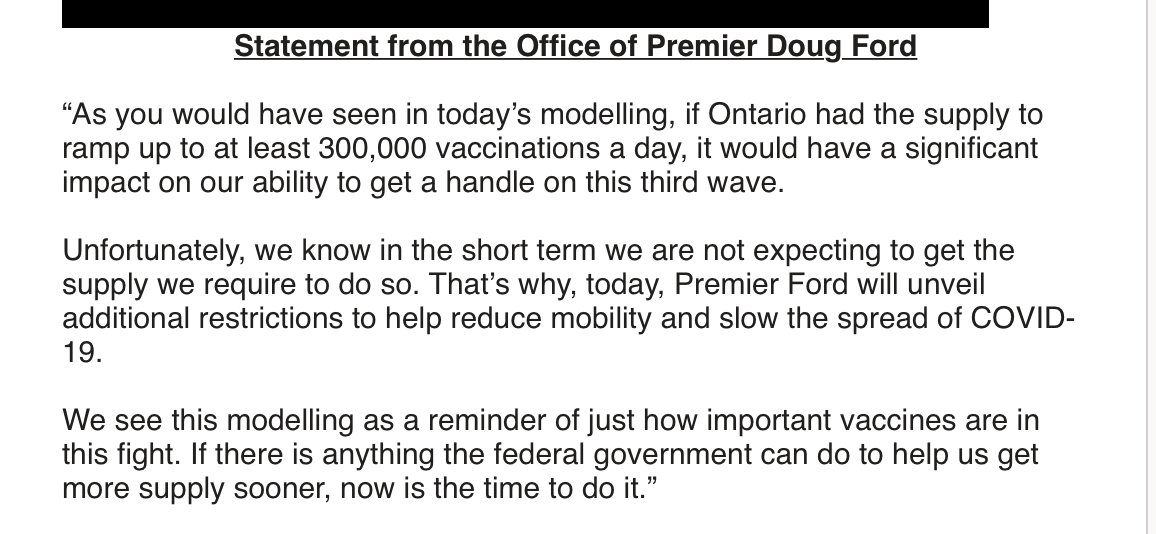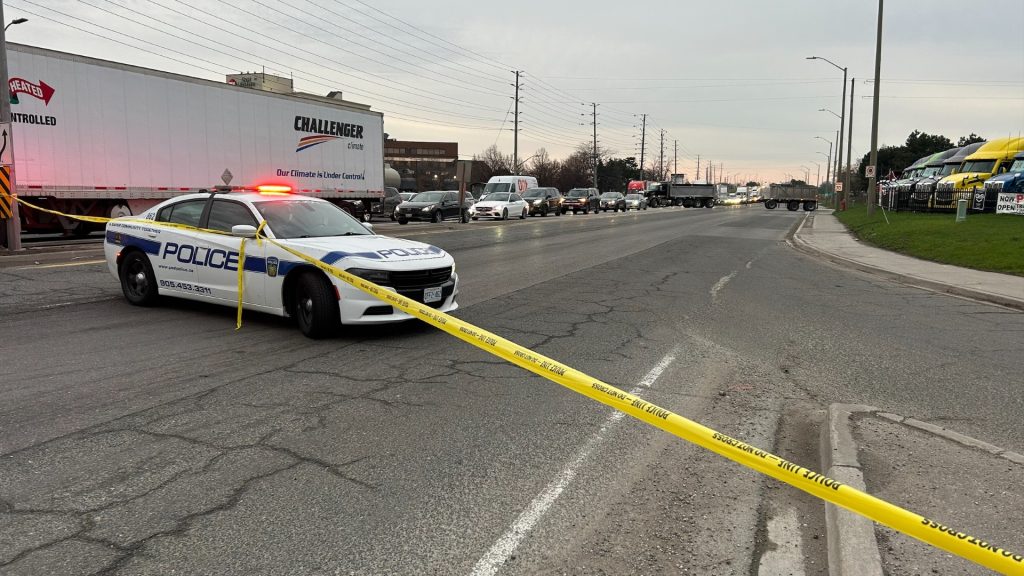Ford announces strict restrictions on outdoor and recreational activities, inter-provincial travel
Posted April 15, 2021 5:37 pm.
Last Updated April 16, 2021 8:17 pm.
A limit of 25 percent max capacity for essential retail, added restrictions to outdoor and recreational activities, and stringent interprovincial travel rules are among the latest public health measures put in place by the Ford government to curve the third wave.
Premier Doug Ford announced the province is extending the stay-at-home order for an additional two weeks, now in place for six weeks and well over a month.
Beginning Saturday at 12:01 a.m., all non-essential construction will be prohibited. Additionally, outdoor activities are now limited to gathering with only members of the same household.
“We’re losing the battle between variants and vaccines,” a somber Ford said Friday.
“We’re down but no means are we out.”
Among the latest changes to public health measures, Ontario’s government says there will be new restrictions on recreational activities such as golf, playgrounds, outdoor soccer, and camping.
Solicitor General Sylvia Jones says police, special constables, and bylaw officers will now be given special authority to enforce public health measures.
This includes an officer’s ability to stop and question anyone on a street or in their cars why they are not at home, and ask for their address.
“If you are not willing to comply, then you are breaking the law,” said Jones.
“This is a critical moment in Ontario’s response to this deadly virus, that’s why we are doing whatever it takes to stop the spread and protect our communities.”
Tickets as high as $750 can be issued.
“Understand restrictions will be strongly, strongly enforced because they must be,” said Ford.
As of April 19th, Ford says interprovincial travel restrictions will be enforced by implementing checkpoints at provincial borders into Quebec and Manitoba with exceptions for essential travel and health.
“We need to tighten our borders. Plain and simple,” Ford added.
#BREAKING – All nonessential construction to close, golf courses and playgrounds to close. Places of worship To to 10 people.
— Richard Southern (@RichardCityNews) April 16, 2021
Other measures include reduced capacity to only 25 percent for big box stores and smaller religious gatherings, such as a maximum of 10 people indoors.
Effective Monday, April 19th at 12:01 a.m., the government is limiting the capacity of weddings, funerals, and rites or ceremonies to 10 people indoors or outdoors.
Sources told 680 NEWS a provincewide curfew was under consideration at the cabinet meeting but was ultimately passed on.
A state of emergency and new stay-at-home order was announced on April 3rd and took effect in Ontario on April 8th in yet another effort to control the third wave of the COVID-19 pandemic.
The order was announced following criticism that the province has not done enough to stop the spread of the virus.
Discount and big box stores have since been limited strictly to in-person retail for sales of groceries, household cleaning supplies, pharmacy items (including pharmaceutical, health care, and personal care items, and pet care supplies) only.
Cabinet met again Friday following the province’s latest round of modelling, which showed Ontario could reach 30,000 daily COVID-19 cases if public health measures are relaxed and a stay-at-home order isn’t in place.
Ford’s office issued a statement shortly before Friday’s announcement on restrictions, saying if Ontario had the supply to ramp up vaccinations to 300,000 it would make a substantial difference as the province aims to flatten the curve.

“Unfortunately, we know in the short term we are not expecting to get the supply we require to do so,” Ford’s office said Friday.
“… We see this modelling as a reminder of just how important vaccines are in this fight. If there is anything the federal government can do to help us get more supply sooner, now is the time to do it.”
Moderna confirmed to the federal government that the next expected shipment of its COVID-19 vaccines that were scheduled for the end of April will now be 650,000 doses instead of 1.2 million.
The drugmaker also said that one to two million doses of the 12.3 million scheduled to arrive in the second quarter could be pushed back to the third quarter.
Ontario’s previous stay-at-home order went into effect on January 14th and was lifted nearly two months later on March 8th.
“As we see the trends in key health indicators deteriorate to levels far exceeding anything we have seen before, it is necessary to follow public health and workplace safety measures given this continued and rapid case growth,” said Dr. David Williams, Chief Medical Officer of Health.
“By staying at home and limiting travel for essential purposes only, such as getting groceries or going to a medical appointment or to get vaccinated, we can reduce mobility and help interrupt transmission of this virus.”
On Monday, Ford announced that all schools in Ontario will be closed to in-person learning indefinitely following the current school break, with students resuming learning activities on April 19th.
The government had previously maintained that schools would reopen next week but unions had called for schools to close in the absence of stronger safety measures.
Private schools operating in-person this week transitioned to remote learning on April 15th.
Ford says data will be assessed on an ongoing basis and health officials will be consulted to determine when it will be safe to resume in-person learning.
Barbara Yaffe said yesterday it is likely we will see our daily COVID-19 cases remain high for the next while, and the number of people in intensive care will increase even more.
She revealed a 36 percent increase in the seven-day average since last week.
RELATED: Ford issues statement amidst backlash from opposition – ‘Stop politicizing the vaccine rollout’
“Remember what things were like last spring when we had the stay-at-home order and what the streets were like. They were pretty much empty. They’re not empty these days,” she said.
“We have to go back to that. We have to go back and think like we did then.”
Prime Minister Justin Trudeau said discussions were ongoing about providing more health-care workers, saying mobile units were already setting up hospital beds in Toronto and Hamilton.
Trudeau acknowledged on Friday that he’s concerned for Ontario and its residents, citing high case counts and ICUs being stretched beyond capacity.
RELATED: Ford refuses help from Trudeau, Red Cross saying vaccine supply is the problem, not capacity
Ford ultimately rejected Trudeau’s offer of federal help to deal with the dire COVID-19 situation in Ontario – especially in the Toronto area.
Earlier Thursday, Solicitor General Jones refused to confirm whether a curfew was among the restrictions under consideration but expressed concern over recent riots in Montreal after one was implemented there.
“I am not going to have a conversation about what cabinet discusses,” she said.
“I think the Montreal riots speak to the challenge of both enforcing and people’s willingness to do a curfew but again, all options are on the table.”
Jones said people are not respecting the stay-at-home order and criticized people seen not wearing masks.
Ontario has issued a plea to all other provinces and territories to send any spare nurses to help cope with rising COVID-19 hospital admissions.
Deputy Health Minister Helen Angus says Ontario is expected to be short more than 4,100 nurses in the hospital sector alone over the next four months.
The province logged 4,812 new cases today, up from Thursday’s record of 4,736.
It is also reporting 25 more deaths related to the virus.
Health Minister Christine Elliott says 1,469 of the new cases are in Toronto, 851 are in Peel Region, 491 are in York Region, 366 are in Ottawa and 268 are in Durham Region.
With files from the Canadian Press










